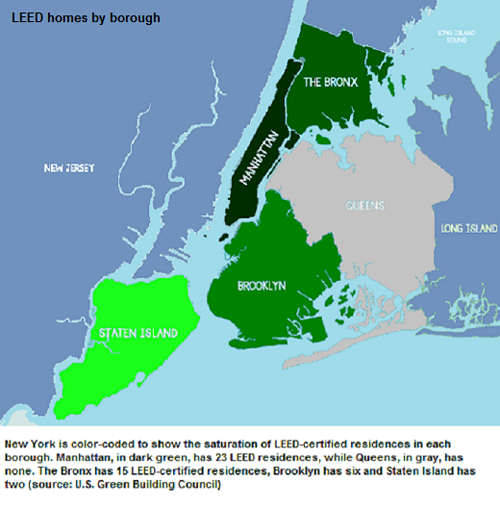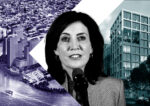Trending
Battery Park City condos ‘LEED’ the way
Queens marks only borough without a single LEED-certified residence

Battery Park City is home to more than one-fifth of the Leadership in Energy and Environmental Design residences in Manhattan, according to data provided to The Real Deal by the U.S. Green Building Council, the group that developed the LEED rating system (see map above for LEED saturation by borough).
Of the 23 LEED-certified residential buildings in Manhattan, five are located on the reclaimed swath of land at the island’s southwest tip: the Riverhouse, the Millennium Tower Residences, the Verdesian, the Tribeca Green and the Solaire, which in 2004 became the first residential tower in the U.S. to go LEED.
Manhattan may be the top borough, but the Bronx is not far behind, with 15 certified residential projects. Queens is the only borough without a single LEED residence, while Brooklyn and Staten Island have six and two, respectively.
While hard numbers on the economic perks of sustainable building are limited, some studies have shown that certifications like LEED help homes sell faster and fetch higher prices.
LEED is not the only measure of a neighborhood’s environmental standing, of course, nor is it the only marker of a sustainable home. But Green Globes, a competing building assessment program run by the Green Building Initiative, has yet to certify a residence in the city (a spokesperson for the organization insisted there would be some within the year) (note: correction appended).
Energy Star, the federal program that measures a building’s energy efficiency, does not keep track of which homes in specific neighborhoods or boroughs have earned the designation. Across the New York-Northern New Jersey-Long Island metropolitan area, there are currently 31,135 Energy Star-qualified homes, no doubt dwarfing the number of LEED homes in the region, although the USGBC data represents a different geographic area.
Russell Unger, the executive director of the New York City chapter of the USGBC, explained the uneven distribution of LEED buildings in Battery Park City and the Bronx by pointing out the two main drivers of green construction: high-end development and the government (note: correction appended).
“LEED’s greatest uptick has really been in two main areas: one is government, which took the early lead as it often does, and the other was the Class A market,” including residential and commercial development, he said.
The Hugh L. Carey Battery Park City Authority, the state-run corporation responsible for maintaining development in the area, implemented a set of environmental guidelines for residential buildings back in 2000 that Unger said helped push LEED into the mainstream.
“Battery Park City really helped train a generation of designers and contractors how to do it,” he said.
The Bronx dominates the outer boroughs thanks to the Rauch-Goldblum residence in Riverdale — which became New York’s first single-family home to earn LEED certification in August 2008 — and a number of environmentally-friendly affordable housing projects financed by the city and private developers.
Brooklyn’s LEED-certified buildings include the Greenbelt condominiums in Williamsburg, the Third + Bond condos in Gowanus, and a 41-unit Habitat for Humanity development in Brownsville that was certified in November 2009.
Meanwhile, Staten Island is home to two LEED-certified residential projects: the 12-acre Markham Gardens development, a 290-unit collection of affordable duplexes and low-rises, and the New Stapleton Waterfront, a 35-acre mixed-use residential community on a decommissioned U.S. Naval base.




